监控指标
Flink任务提交得集群后,需要对任务进行有效监控,对Flink得监控指标可以分为系统指标和用户指标。Flink 提供的 Metrics 可以在 Flink 内部收集一些指标,通过这些指标让开发人员更好地理解作业或集群的状态。由于集群运行后很难发现内部的实际状况, Metrics 可以很好的帮助开发人员了解作业的当前状况。
系统指标:
- CPU负载
- 组件内存使用情况
用户指标
- 自定义注册监控指标
- 用户业务状态信息
在FlinkWeb中我们可以看到系统对应的TaskManager、TaskSlots以及Job相关的信息

访问相关界面可以拿到对应的监控指标名称

通过get方式获取到相关指标的数值

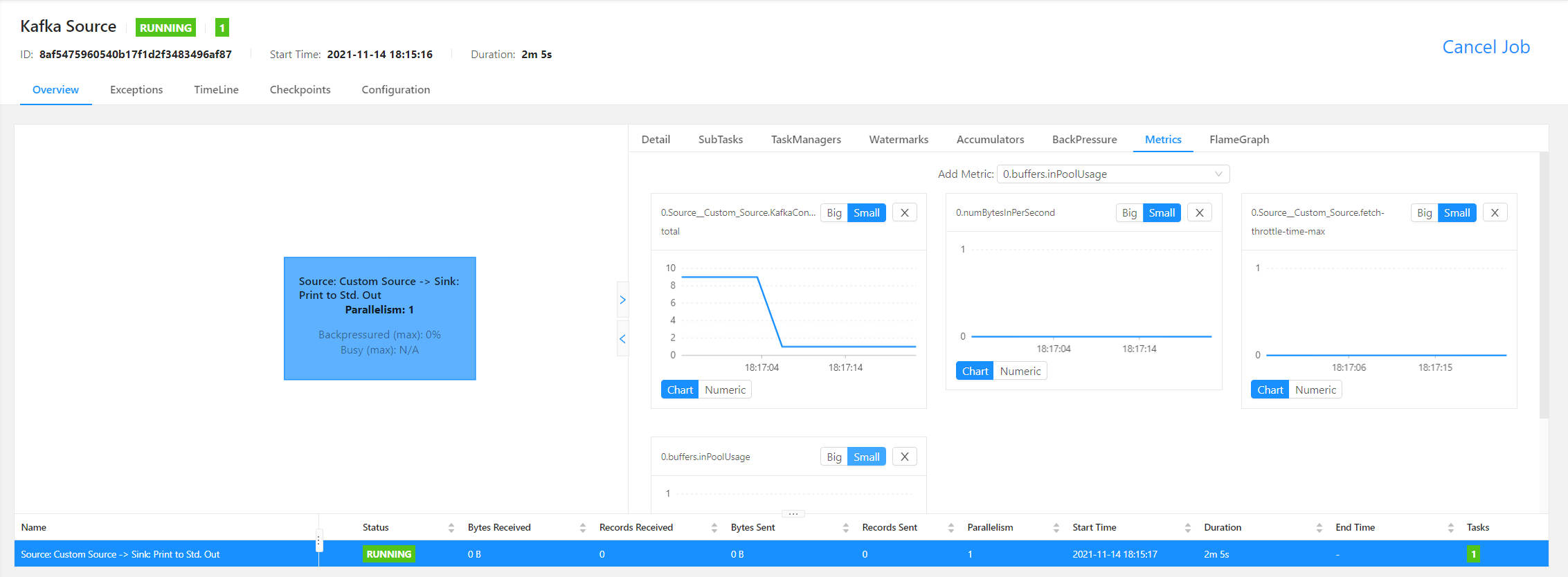
这样子看不是特别方便我们这里采用Promethus的方式对来采集Flink-Metrics,并对其进行可视化展示。
Promethus配置
对于Promethus这里不在详细介绍,使用Promethus Reporter将指标发送到Prometheus中,首先在启动集群前将 flink-metrics-prometheus_2.12-1.13.2.jar 放到 flink的lib目录下,在flink-conf.yaml中配置Promethus Reporter的相关信息。
metrics.reporter.prom.class: org.apache.flink.metrics.prometheus.PrometheusReporter
metrics.reporter.prom.port: 9260另外一种方式是使用PromethusPushGateway,将指标发送到指定的网关中,然后Promethus从该网关拉去数据,对应得配置如下所示
metrics.reporter.promgateway.class: org.apache.flink.metrics.prometheus.PrometheusPushGatewayReporter
metrics.reporter.promgateway.host: node1
metrics.reporter.promgateway.port: 9091
metrics.reporter.promgateway.jobName: myJob
metrics.reporter.promgateway.randomJobNameSuffix: true
metrics.reporter.promgateway.deleteOnShutdown: false
metrics.reporter.promgateway.groupingKey: k1=v1;k2=v2metrics.reporter.promgateway.interval: 10 SECONDS本文没有使用这种方法,这里我门使用的是第一种Promethus Reporter,在flink-conf.yaml 添加如下配置
metrics.reporter.prom.class: org.apache.flink.metrics.prometheus.PrometheusReporter
metrics.reporter.prom.port: 9260将 flink-conf.yaml 配置文件和flink-metrics-prometheus_2.12-1.13.2.jar分发到各个计算节点,然后重启flink集群,在promethus.yml中添加
- job_name: 'flink_metrics'
static_configs:
- targets: ['hadoop102:9260','hadoop103:9260','hadoop104:9260']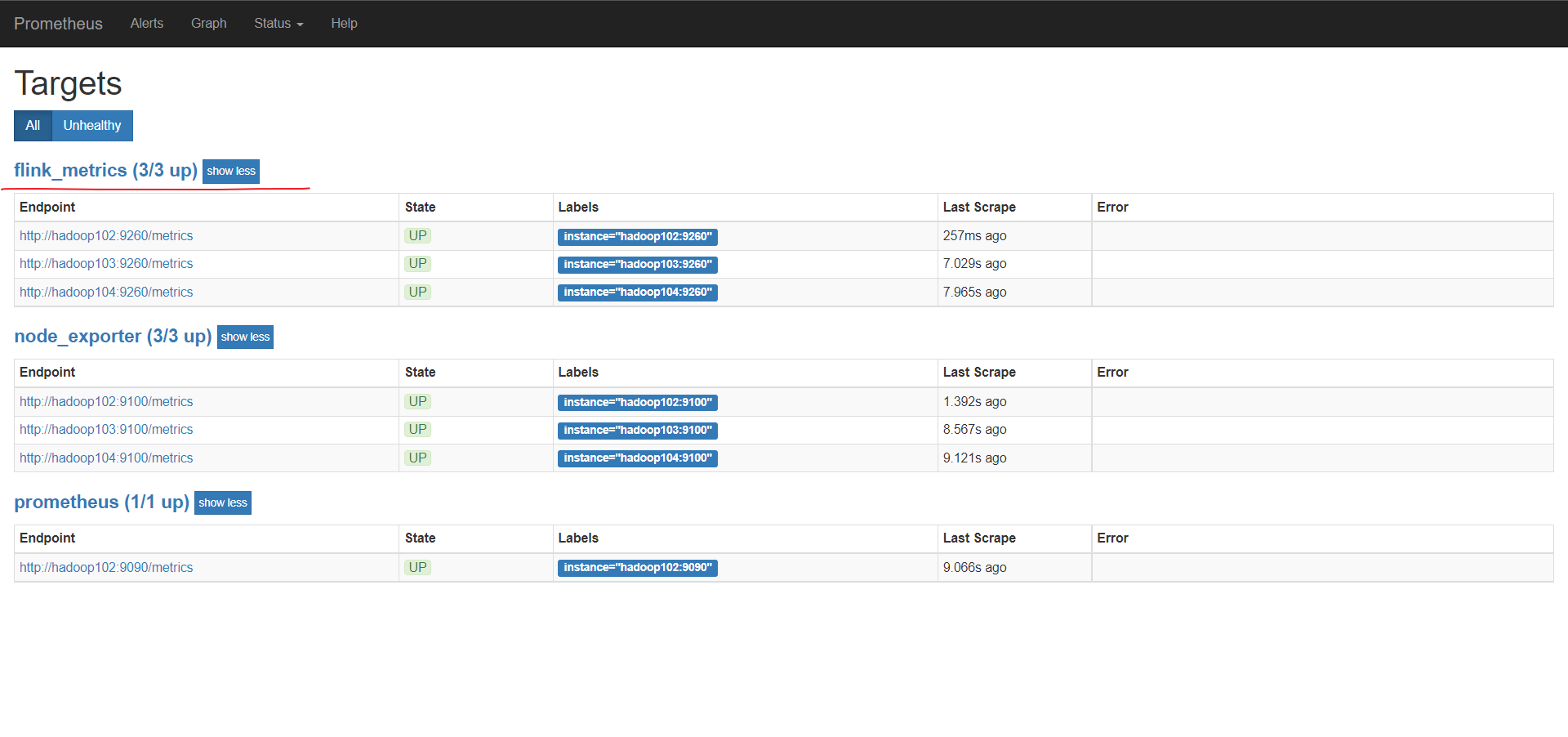
Flink-metrics相关组件已经启动,测试作业如下:
package cn.hphblog.job;
import com.google.gson.Gson;
import org.apache.flink.api.common.functions.FlatMapFunction;
import org.apache.flink.api.common.functions.ReduceFunction;
import org.apache.flink.api.common.restartstrategy.RestartStrategies;
import org.apache.flink.api.common.serialization.SimpleStringSchema;
import org.apache.flink.api.common.time.Time;
import org.apache.flink.api.java.tuple.Tuple2;
import org.apache.flink.streaming.api.TimeCharacteristic;
import org.apache.flink.streaming.api.datastream.DataStreamSource;
import org.apache.flink.streaming.api.datastream.KeyedStream;
import org.apache.flink.streaming.api.datastream.SingleOutputStreamOperator;
import org.apache.flink.streaming.api.environment.StreamExecutionEnvironment;
import org.apache.flink.streaming.connectors.kafka.FlinkKafkaConsumer;
import org.apache.flink.util.Collector;
import java.util.Properties;
public class HelloFlink {
public static void main(String[] args) throws Exception {
StreamExecutionEnvironment environment = StreamExecutionEnvironment.getExecutionEnvironment();
environment.setStreamTimeCharacteristic(TimeCharacteristic.ProcessingTime);
Properties props = new Properties();
//指定kafka的Broker地址
props.setProperty("bootstrap.servers", "hadoop102:9092,hadoop103:9092,hadoop104:9092");
//设置组ID
props.setProperty("group.id", "us_ac");
props.setProperty("auto.offset.reset", "earliest");
//kafka自动提交偏移量,
props.setProperty("enable.auto.commit", "false");
//{"Id":295,"Name":"Nmae_295","Operation":"add","t":1636887111,"opt":0}
FlinkKafkaConsumer<String> kafkaSouce = new FlinkKafkaConsumer<>("us_ac", //指定Topic
new SimpleStringSchema(), //指定Schema,生产中一般使用Avro
props); //Kafka配置
//checkpoint开启
environment.enableCheckpointing(5000);
//重试策略开启
environment.getConfig().setRestartStrategy(RestartStrategies.fixedDelayRestart(2, Time.seconds(2)));
DataStreamSource<String> streamSource = environment.addSource(kafkaSouce);
SingleOutputStreamOperator<Tuple2<String, Integer>> flatMap = streamSource.flatMap(new FlatMapFunction<String, Tuple2<String, Integer>>() {
@Override
public void flatMap(String s, Collector<Tuple2<String, Integer>> collector) throws Exception {
UserAction userAction = new Gson().fromJson(s, UserAction.class);
collector.collect(Tuple2.of(userAction.getOperation(), userAction.getOpt()));
}
});
KeyedStream<Tuple2<String, Integer>, String> tuple2StringKeyedStream = flatMap.keyBy(x -> x.f0);
tuple2StringKeyedStream.timeWindow(org.apache.flink.streaming.api.windowing.time.Time.seconds(5)).reduce(new ReduceFunction<Tuple2<String, Integer>>() {
@Override
public Tuple2<String, Integer> reduce(Tuple2<String, Integer> t1, Tuple2<String, Integer> t2) throws Exception {
return Tuple2.of(t1.f0, t1.f1 + t2.f1);
}
}).print();
environment.execute("Flink Metrics");
}
}package cn.hphblog.job;
public class UserAction {
private int Id;
private String Name;
private String Operation;
private Long t;
private int opt;
public int getId() {
return Id;
}
public void setId(int id) {
Id = id;
}
public String getName() {
return Name;
}
public void setName(String name) {
Name = name;
}
public String getOperation() {
return Operation;
}
public void setOperation(String operation) {
Operation = operation;
}
public Long getT() {
return t;
}
public void setT(Long t) {
this.t = t;
}
public int getOpt() {
return opt;
}
public void setOpt(int opt) {
this.opt = opt;
}
public UserAction(int id, String name, String operation, Long t, int opt) {
Id = id;
Name = name;
Operation = operation;
this.t = t;
this.opt = opt;
}
public UserAction() {
}
@Override
public String toString() {
return "UserAction{" +
"Id=" + Id +
", Name='" + Name + '\'' +
", Operation='" + Operation + '\'' +
", t=" + t +
", opt=" + opt +
'}';
}
}Grafna配置
Grafna如果联网配置也相对简单,https://grafana.com/grafana/dashboards/14911
只需要引入ID为14911即可
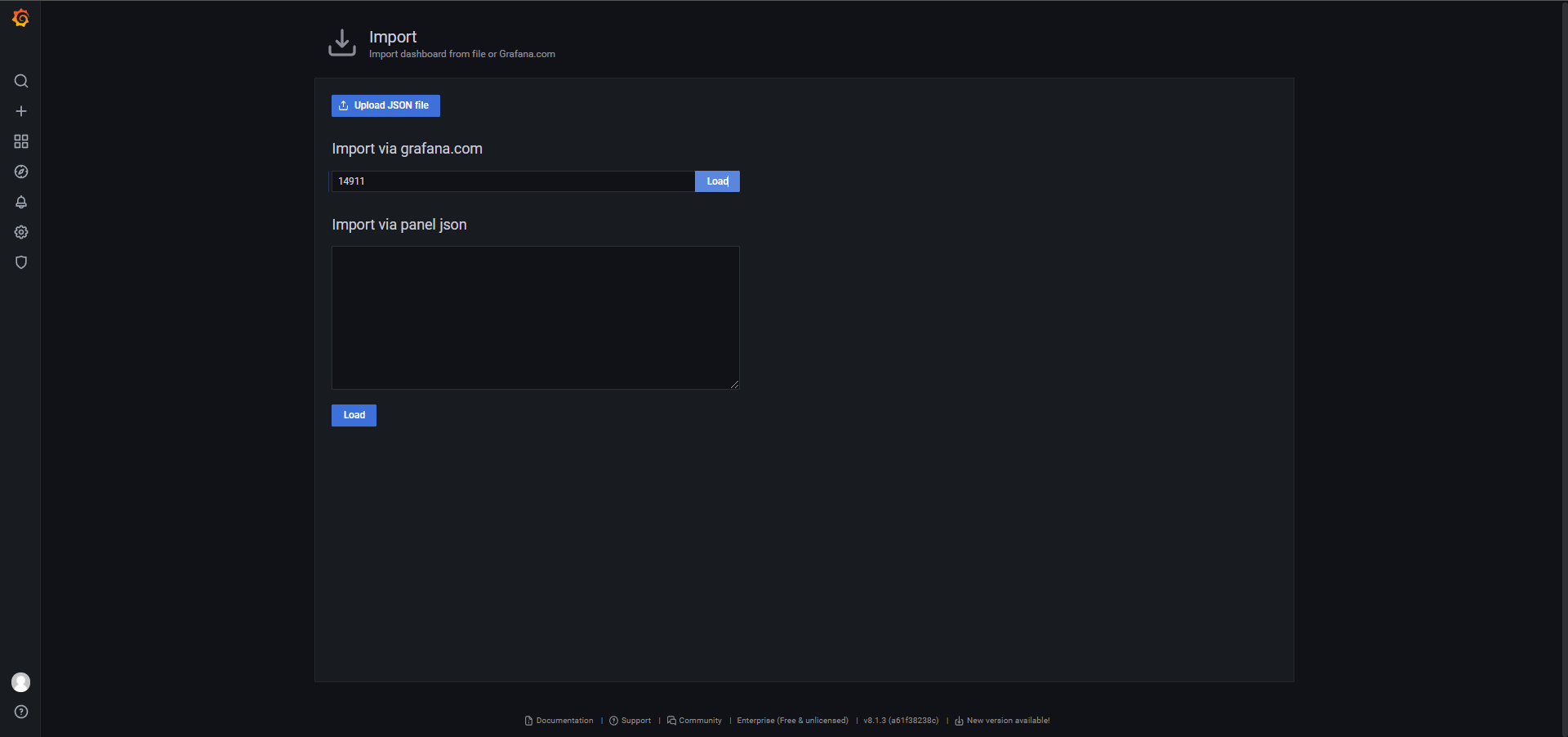
效果如下
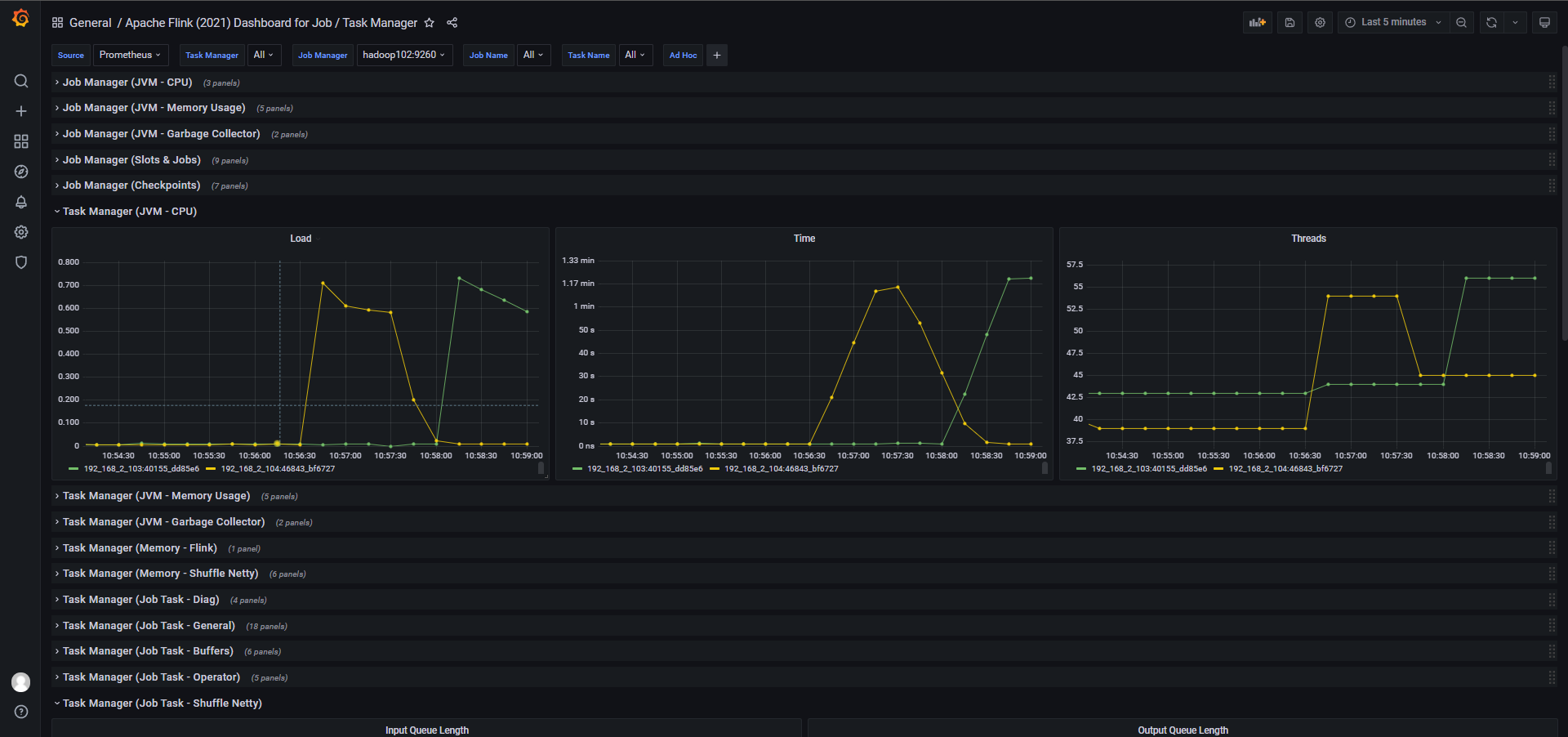
告警
在监控告警中我们往往会遇到如下得问题。
- 阈值设定:不同业务场景,不同指标,如何衡量阈值是过于宽松,还是过于严格。
- 流量波动:在理想的世界里,流量是有起伏规律的,监控系统能够掌握这种规律,当流量上升时,告警阈值自动上升
- 瞬态告警:每个人都会遇到这样的情况,同样的问题隔段时间就出现一次,持续时间不过几分钟,来得快去得也快。说实话,你已经忙得不可开交了,近期内也不大会去排除这种问题。是忽略呢?还是忽略呢?
- 信息过载:典型的信息过载场景是,给所有需要的地方都加上了告警,以为这样即可高枕无忧了,结果随着而来的是,各种来源的告警轻松挤满你的收件箱。
- 故障定位:在相对复杂的业务场景下,一个“告警事件” 除了包含“时间”(何时发生)、“地点”(哪个服务器/组件)、“内容”(包括错误码、状态值等)外,还包含地区、机房、服务、接口等,故障定位之路道阻且长。
基于Promethus我们可以构建出业务所有服务的的监控指标和用户看板,然而这还是不够的,这个时候我们需要用到告警。
我们需要使用到 alertmanager相关的东西,这里对alertmanager 不在做过多介绍,修改promethus.yaml中修改相关配置添加
# Alertmanager configuration
alerting:
alertmanagers:
- static_configs:
- targets:
- hadoop102:9093
# Load rules once and periodically evaluate them according to the global 'evaluation_interval'.
rule_files:
- "/opt/module/prometheus-2.3.0.linux-amd64/rules/*.rules"
根据实际的情况修改相关配置,flink集群运行任务告警规则配置如下,对于当集群任务不存在时,发送告警相关的邮件
groups:
- name: flink-job
rules:
- alert: flink-job
expr: flink_jobmanager_numRunningJobs == 0
for: 10s
labels:
severity: 1
team: node
annotations:
summary: "{{ $labels.job }} 任务已经停止"同时修改alertmanager.yml配置文件
global:
smtp_smarthost: 'smtp.qq.com:465' #QQ邮箱服务器
smtp_from: '467008580@qq.com' #发送邮箱
smtp_auth_username: '467008580@qq.com' #名称
smtp_auth_password: 'xxxxxxxxx' # 授权码
smtp_require_tls: false
route:
group_by: ['alertname']
group_wait: 30s
group_interval: 5m
repeat_interval: 1h
receiver: 'email'
- name: 'email'
email_configs:
- to: 'xxxxx@wo.cn'
send_resolved: true
inhibit_rules:
- source_match:
severity: 'critical'
target_match:
severity: 'warning'
equal: ['alertname', 'dev', 'instance']由于我们在Flink集群上目前没有运行任何的任务
所以告警一会儿就会触发。

当然也可以选择电话,钉钉等相关告警配置,对于Flink任务监控基本和Promethus监控类似,配置相关的告警规则即可。
自定义Metrics
Metric分类
Counter
Counter:对一个计数器进行累加,即对于多条数据和多兆数据一直往上加的过程。
Gauge
反映一个值。比如要看现在 Java heap 内存用了多少,就可以每次实时的暴露一个 Gauge,Gauge 当前的值就是 heap 使用的量。
Meter
Meter 是指统计吞吐量和单位时间内发生“事件”的次数。它相当于求一种速率,即事件次数除以使用的时间。
Histogram
用于统计一些数据的分布,比如说 Quantile、Mean、StdDev、Max、Min 等。
Metric Group
Metric 在 Flink 内部有多层结构,以 Group 的方式组织,不是一个扁平化的结构,Metric Group + Metric Name 是 Metrics 的唯一标识。
Metric Group 的层级有 TaskManagerMetricGroup 和 TaskManagerJobMetricGroup,每个 Job 具体到某一个 task 的 group,task 又分为 TaskIOMetricGroup 和 OperatorMetricGroup。Operator 下面也有 IO 统计和一些 Metrics,整个层级大概如下图所示。Metrics 不会影响系统,它处在不同的组中,并且 Flink 支持自己去加 Group,可以有自己的层级。
•TaskManagerMetricGroup
•TaskManagerJobMetricGroup
•TaskMetricGroup
•TaskIOMetricGroup
•OperatorMetricGroup
•${User-defined Group} / ${User-defined Metrics}
•OperatorIOMetricGroup
•JobManagerMetricGroup
•JobManagerJobMetricGroupCounter
package cn.hphblog.job;
import com.google.gson.Gson;
import org.apache.flink.api.common.functions.FlatMapFunction;
import org.apache.flink.api.common.functions.ReduceFunction;
import org.apache.flink.api.common.functions.RichMapFunction;
import org.apache.flink.api.common.restartstrategy.RestartStrategies;
import org.apache.flink.api.common.serialization.SimpleStringSchema;
import org.apache.flink.api.common.time.Time;
import org.apache.flink.api.java.tuple.Tuple2;
import org.apache.flink.configuration.Configuration;
import org.apache.flink.metrics.Counter;
import org.apache.flink.streaming.api.TimeCharacteristic;
import org.apache.flink.streaming.api.datastream.DataStreamSource;
import org.apache.flink.streaming.api.datastream.KeyedStream;
import org.apache.flink.streaming.api.datastream.SingleOutputStreamOperator;
import org.apache.flink.streaming.api.environment.StreamExecutionEnvironment;
import org.apache.flink.streaming.connectors.kafka.FlinkKafkaConsumer;
import org.apache.flink.util.Collector;
import java.util.Properties;
public class MyCustomCounter {
public static void main(String[] args) throws Exception {
StreamExecutionEnvironment environment = StreamExecutionEnvironment.getExecutionEnvironment();
environment.setStreamTimeCharacteristic(TimeCharacteristic.ProcessingTime);
Properties props = new Properties();
//指定kafka的Broker地址
props.setProperty("bootstrap.servers", "hadoop102:9092,hadoop103:9092,hadoop104:9092");
//设置组ID
props.setProperty("group.id", "my_counter");
props.setProperty("auto.offset.reset", "earliest");
//kafka自动提交偏移量,
props.setProperty("enable.auto.commit", "false");
//{"Id":295,"Name":"Nmae_295","Operation":"add","t":1636887111,"opt":0}
FlinkKafkaConsumer<String> kafkaSouce = new FlinkKafkaConsumer<>("us_ac", //指定Topic
new SimpleStringSchema(), //指定Schema,生产中一般使用Avro
props); //Kafka配置
//checkpoint开启
environment.enableCheckpointing(5000);
//重试策略开启
environment.getConfig().setRestartStrategy(RestartStrategies.fixedDelayRestart(2, Time.seconds(2)));
DataStreamSource<String> streamSource = environment.addSource(kafkaSouce);
SingleOutputStreamOperator<Tuple2<String, Integer>> flatMap = streamSource.flatMap(new FlatMapFunction<String, Tuple2<String, Integer>>() {
@Override
public void flatMap(String s, Collector<Tuple2<String, Integer>> collector) throws Exception {
UserAction userAction = new Gson().fromJson(s, UserAction.class);
collector.collect(Tuple2.of(userAction.getOperation(), userAction.getOpt()));
}
});
//flink Counter Metrics
flatMap.map(new RichMapFunction<Tuple2<String, Integer>, Tuple2<String, Integer>>() {
private transient Counter counter;
@Override
public void open(Configuration parameters) throws Exception {
this.counter = getRuntimeContext()
.getMetricGroup()
.counter("myCounter");
}
@Override
public Tuple2<String, Integer> map(Tuple2<String, Integer> value) throws Exception {
this.counter.inc();
return value;
}
});
KeyedStream<Tuple2<String, Integer>, String> tuple2StringKeyedStream = flatMap.keyBy(x -> x.f0);
tuple2StringKeyedStream.timeWindow(org.apache.flink.streaming.api.windowing.time.Time.seconds(5)).
reduce(new ReduceFunction<Tuple2<String, Integer>>() {
@Override
public Tuple2<String, Integer> reduce(Tuple2<String, Integer> t1, Tuple2<String, Integer> t2) throws
Exception {
return Tuple2.of(t1.f0, t1.f1 + t2.f1);
}
}).print();
environment.execute("Flink Metrics Counter");
}
}
Gauge
package cn.hphblog.job;
import com.google.gson.Gson;
import org.apache.flink.api.common.functions.FlatMapFunction;
import org.apache.flink.api.common.functions.ReduceFunction;
import org.apache.flink.api.common.functions.RichMapFunction;
import org.apache.flink.api.common.restartstrategy.RestartStrategies;
import org.apache.flink.api.common.serialization.SimpleStringSchema;
import org.apache.flink.api.common.time.Time;
import org.apache.flink.api.java.tuple.Tuple2;
import org.apache.flink.configuration.Configuration;
import org.apache.flink.metrics.Gauge;
import org.apache.flink.streaming.api.TimeCharacteristic;
import org.apache.flink.streaming.api.datastream.DataStreamSource;
import org.apache.flink.streaming.api.datastream.KeyedStream;
import org.apache.flink.streaming.api.datastream.SingleOutputStreamOperator;
import org.apache.flink.streaming.api.environment.StreamExecutionEnvironment;
import org.apache.flink.streaming.connectors.kafka.FlinkKafkaConsumer;
import org.apache.flink.util.Collector;
import java.util.Properties;
public class MyCustomGauge {
public static void main(String[] args) throws Exception {
StreamExecutionEnvironment environment = StreamExecutionEnvironment.getExecutionEnvironment();
environment.setStreamTimeCharacteristic(TimeCharacteristic.ProcessingTime);
Properties props = new Properties();
//指定kafka的Broker地址
props.setProperty("bootstrap.servers", "hadoop102:9092,hadoop103:9092,hadoop104:9092");
//设置组ID
props.setProperty("group.id", "my_counter");
props.setProperty("auto.offset.reset", "earliest");
//kafka自动提交偏移量,
props.setProperty("enable.auto.commit", "false");
//{"Id":295,"Name":"Nmae_295","Operation":"add","t":1636887111,"opt":0}
FlinkKafkaConsumer<String> kafkaSouce = new FlinkKafkaConsumer<>("us_ac", //指定Topic
new SimpleStringSchema(), //指定Schema,生产中一般使用Avro
props); //Kafka配置
//checkpoint开启
environment.enableCheckpointing(5000);
//重试策略开启
environment.getConfig().setRestartStrategy(RestartStrategies.fixedDelayRestart(2, Time.seconds(2)));
DataStreamSource<String> streamSource = environment.addSource(kafkaSouce);
SingleOutputStreamOperator<Tuple2<String, Integer>> flatMap = streamSource.flatMap(new FlatMapFunction<String, Tuple2<String, Integer>>() {
@Override
public void flatMap(String s, Collector<Tuple2<String, Integer>> collector) throws Exception {
UserAction userAction = new Gson().fromJson(s, UserAction.class);
collector.collect(Tuple2.of(userAction.getOperation(), userAction.getOpt()));
}
});
//flink Counter Metrics
flatMap.map(new RichMapFunction<Tuple2<String, Integer>, Tuple2<String, Integer>>() {
private transient int valueToExpose = 0;
@Override
public void open(Configuration parameters) throws Exception {
getRuntimeContext()
.getMetricGroup()
.gauge("MyGauge", new Gauge<Integer>() {
@Override
public Integer getValue() {
return valueToExpose;
}
});
}
@Override
public Tuple2<String, Integer> map(Tuple2<String, Integer> value) throws Exception {
valueToExpose++;
return value;
}
});
KeyedStream<Tuple2<String, Integer>, String> tuple2StringKeyedStream = flatMap.keyBy(x -> x.f0);
tuple2StringKeyedStream.timeWindow(org.apache.flink.streaming.api.windowing.time.Time.seconds(5)).
reduce(new ReduceFunction<Tuple2<String, Integer>>() {
@Override
public Tuple2<String, Integer> reduce(Tuple2<String, Integer> t1, Tuple2<String, Integer> t2) throws
Exception {
return Tuple2.of(t1.f0, t1.f1 + t2.f1);
}
}).print();
environment.execute("Flink Metrics Gauge");
}
}
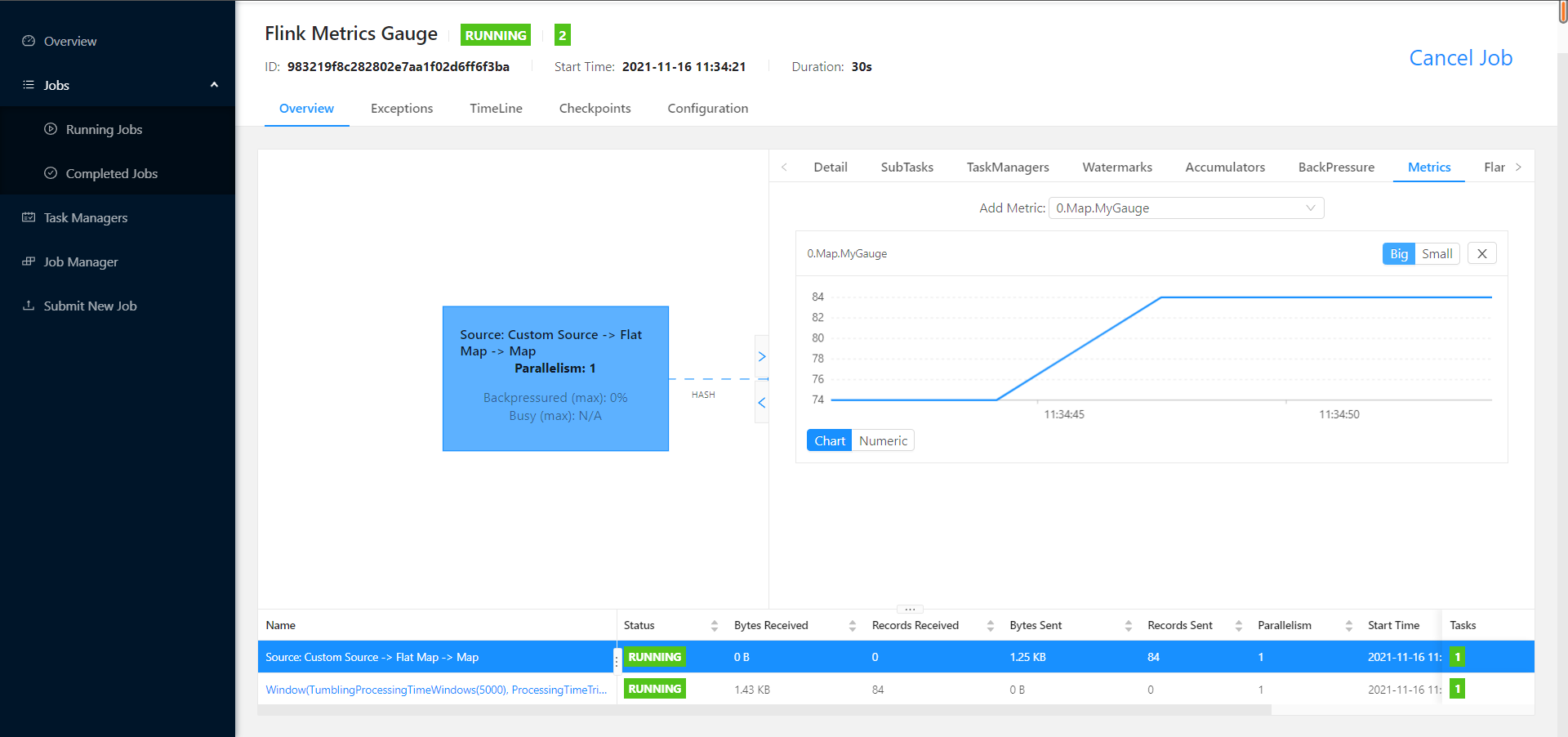
Meter
package cn.hphblog.job;
import com.google.gson.Gson;
import org.apache.flink.api.common.functions.FlatMapFunction;
import org.apache.flink.api.common.functions.ReduceFunction;
import org.apache.flink.api.common.functions.RichMapFunction;
import org.apache.flink.api.common.restartstrategy.RestartStrategies;
import org.apache.flink.api.common.serialization.SimpleStringSchema;
import org.apache.flink.api.common.time.Time;
import org.apache.flink.api.java.tuple.Tuple2;
import org.apache.flink.configuration.Configuration;
import org.apache.flink.dropwizard.metrics.DropwizardMeterWrapper;
import org.apache.flink.metrics.Meter;
import org.apache.flink.streaming.api.TimeCharacteristic;
import org.apache.flink.streaming.api.datastream.DataStreamSource;
import org.apache.flink.streaming.api.datastream.KeyedStream;
import org.apache.flink.streaming.api.datastream.SingleOutputStreamOperator;
import org.apache.flink.streaming.api.environment.StreamExecutionEnvironment;
import org.apache.flink.streaming.connectors.kafka.FlinkKafkaConsumer;
import org.apache.flink.util.Collector;
import java.util.Properties;
public class MyCustomMeter {
public static void main(String[] args) throws Exception {
StreamExecutionEnvironment environment = StreamExecutionEnvironment.getExecutionEnvironment();
environment.setStreamTimeCharacteristic(TimeCharacteristic.ProcessingTime);
Properties props = new Properties();
//指定kafka的Broker地址
props.setProperty("bootstrap.servers", "hadoop102:9092,hadoop103:9092,hadoop104:9092");
//设置组ID
props.setProperty("group.id", "my_meter");
props.setProperty("auto.offset.reset", "earliest");
//kafka自动提交偏移量,
props.setProperty("enable.auto.commit", "false");
//{"Id":295,"Name":"Nmae_295","Operation":"add","t":1636887111,"opt":0}
FlinkKafkaConsumer<String> kafkaSouce = new FlinkKafkaConsumer<>("us_ac", //指定Topic
new SimpleStringSchema(), //指定Schema,生产中一般使用Avro
props); //Kafka配置
//checkpoint开启
environment.enableCheckpointing(5000);
//重试策略开启
environment.getConfig().setRestartStrategy(RestartStrategies.fixedDelayRestart(2, Time.seconds(2)));
DataStreamSource<String> streamSource = environment.addSource(kafkaSouce);
SingleOutputStreamOperator<Tuple2<String, Integer>> flatMap = streamSource.flatMap(new FlatMapFunction<String, Tuple2<String, Integer>>() {
@Override
public void flatMap(String s, Collector<Tuple2<String, Integer>> collector) throws Exception {
UserAction userAction = new Gson().fromJson(s, UserAction.class);
collector.collect(Tuple2.of(userAction.getOperation(), userAction.getOpt()));
}
});
//flink Counter Metrics
flatMap.map(new RichMapFunction<Tuple2<String, Integer>, Tuple2<String, Integer>>() {
private transient Meter meter;
@Override
public void open(Configuration parameters) throws Exception {
com.codahale.metrics.Meter dropwizardMeter = new com.codahale.metrics.Meter();
this.meter = getRuntimeContext()
.getMetricGroup()
.meter("myMeter", new DropwizardMeterWrapper(dropwizardMeter));
}
@Override
public Tuple2<String, Integer> map(Tuple2<String, Integer> value) throws Exception {
this.meter.markEvent();
return value;
}
});
KeyedStream<Tuple2<String, Integer>, String> tuple2StringKeyedStream = flatMap.keyBy(x -> x.f0);
tuple2StringKeyedStream.timeWindow(org.apache.flink.streaming.api.windowing.time.Time.seconds(5)).
reduce(new ReduceFunction<Tuple2<String, Integer>>() {
@Override
public Tuple2<String, Integer> reduce(Tuple2<String, Integer> t1, Tuple2<String, Integer> t2) throws
Exception {
return Tuple2.of(t1.f0, t1.f1 + t2.f1);
}
}).print();
environment.execute("Flink Metrics Meter");
}
}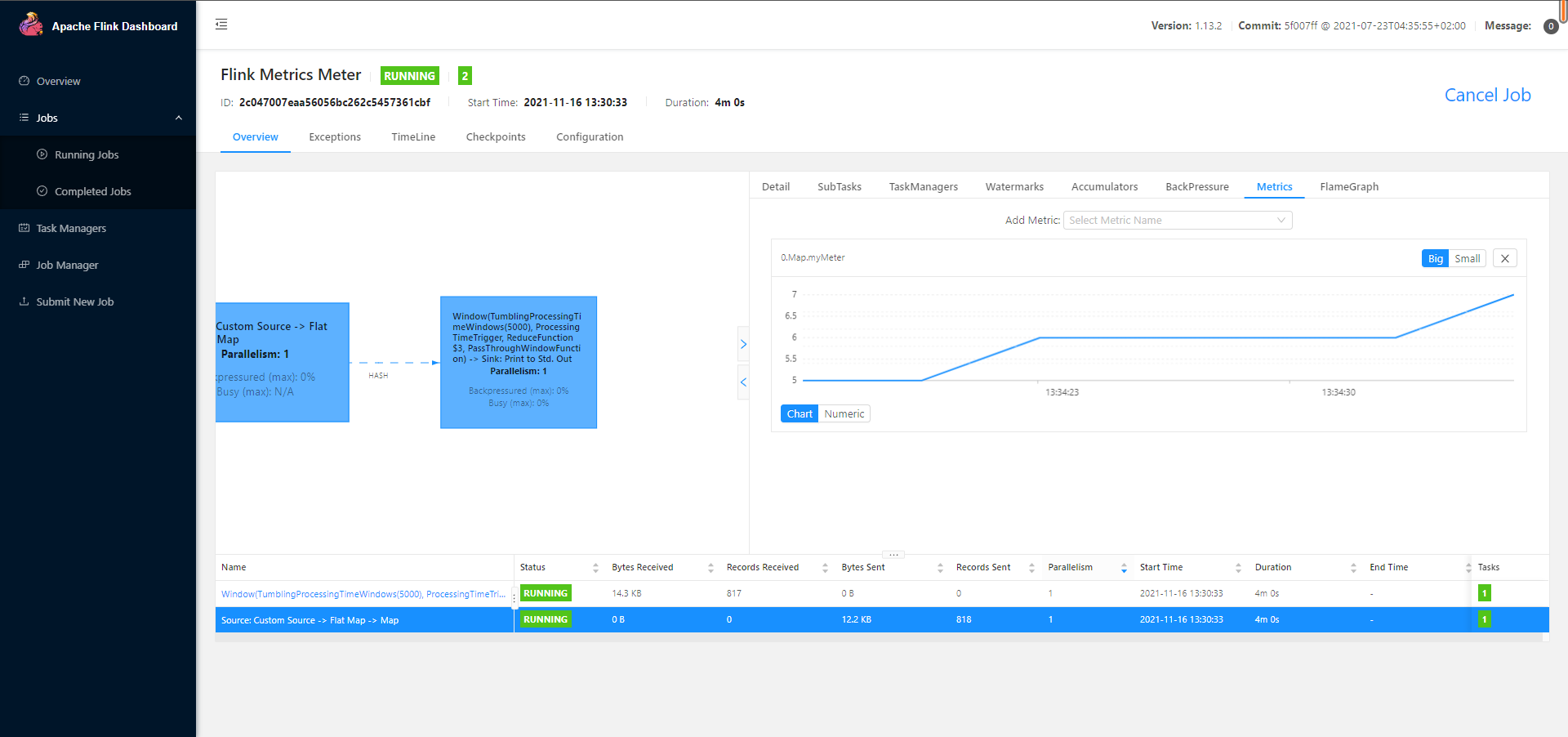
加速发送Kafka数据到us_ac 这一topic中即刻看到相关的趋势变化。
Histogram
package cn.hphblog.job;
import com.codahale.metrics.SlidingWindowReservoir;
import com.google.gson.Gson;
import org.apache.flink.api.common.functions.FlatMapFunction;
import org.apache.flink.api.common.functions.ReduceFunction;
import org.apache.flink.api.common.functions.RichMapFunction;
import org.apache.flink.api.common.restartstrategy.RestartStrategies;
import org.apache.flink.api.common.serialization.SimpleStringSchema;
import org.apache.flink.api.common.time.Time;
import org.apache.flink.api.java.tuple.Tuple2;
import org.apache.flink.configuration.Configuration;
import org.apache.flink.dropwizard.metrics.DropwizardHistogramWrapper;
import org.apache.flink.metrics.Histogram;
import org.apache.flink.streaming.api.TimeCharacteristic;
import org.apache.flink.streaming.api.datastream.DataStreamSource;
import org.apache.flink.streaming.api.datastream.KeyedStream;
import org.apache.flink.streaming.api.datastream.SingleOutputStreamOperator;
import org.apache.flink.streaming.api.environment.StreamExecutionEnvironment;
import org.apache.flink.streaming.connectors.kafka.FlinkKafkaConsumer;
import org.apache.flink.util.Collector;
import java.util.Properties;
public class MyCustomHistogram {
public static void main(String[] args) throws Exception {
StreamExecutionEnvironment environment = StreamExecutionEnvironment.getExecutionEnvironment();
environment.setStreamTimeCharacteristic(TimeCharacteristic.ProcessingTime);
Properties props = new Properties();
//指定kafka的Broker地址
props.setProperty("bootstrap.servers", "hadoop102:9092,hadoop103:9092,hadoop104:9092");
//设置组ID
props.setProperty("group.id", "my_histogram");
props.setProperty("auto.offset.reset", "earliest");
//kafka自动提交偏移量,
props.setProperty("enable.auto.commit", "false");
//{"Id":295,"Name":"Nmae_295","Operation":"add","t":1636887111,"opt":0}
FlinkKafkaConsumer<String> kafkaSouce = new FlinkKafkaConsumer<>("us_ac", //指定Topic
new SimpleStringSchema(), //指定Schema,生产中一般使用Avro
props); //Kafka配置
//checkpoint开启
environment.enableCheckpointing(5000);
//重试策略开启
environment.getConfig().setRestartStrategy(RestartStrategies.fixedDelayRestart(2, Time.seconds(2)));
DataStreamSource<String> streamSource = environment.addSource(kafkaSouce);
SingleOutputStreamOperator<Tuple2<String, Integer>> flatMap = streamSource.flatMap(new FlatMapFunction<String, Tuple2<String, Integer>>() {
@Override
public void flatMap(String s, Collector<Tuple2<String, Integer>> collector) throws Exception {
UserAction userAction = new Gson().fromJson(s, UserAction.class);
collector.collect(Tuple2.of(userAction.getOperation(), userAction.getOpt()));
}
});
//flink Histogram Metrics
flatMap.map(new RichMapFunction<Tuple2<String, Integer>, Tuple2<String, Integer>>() {
private transient Histogram histogram;
@Override
public void open(Configuration parameters) throws Exception {
com.codahale.metrics.Histogram dropwizardHistogram =
new com.codahale.metrics.Histogram(new SlidingWindowReservoir(500));
this.histogram = getRuntimeContext()
.getMetricGroup()
.histogram("myHistogram", new DropwizardHistogramWrapper(dropwizardHistogram));
}
@Override
public Tuple2<String, Integer> map(Tuple2<String, Integer> value) throws Exception {
this.histogram.update(value.f1);
return value;
}
});
KeyedStream<Tuple2<String, Integer>, String> tuple2StringKeyedStream = flatMap.keyBy(x -> x.f0);
tuple2StringKeyedStream.timeWindow(org.apache.flink.streaming.api.windowing.time.Time.seconds(5)).
reduce(new ReduceFunction<Tuple2<String, Integer>>() {
@Override
public Tuple2<String, Integer> reduce(Tuple2<String, Integer> t1, Tuple2<String, Integer> t2) throws
Exception {
return Tuple2.of(t1.f0, t1.f1 + t2.f1);
}
}).print();
environment.execute("Flink Metrics Histogram");
}
}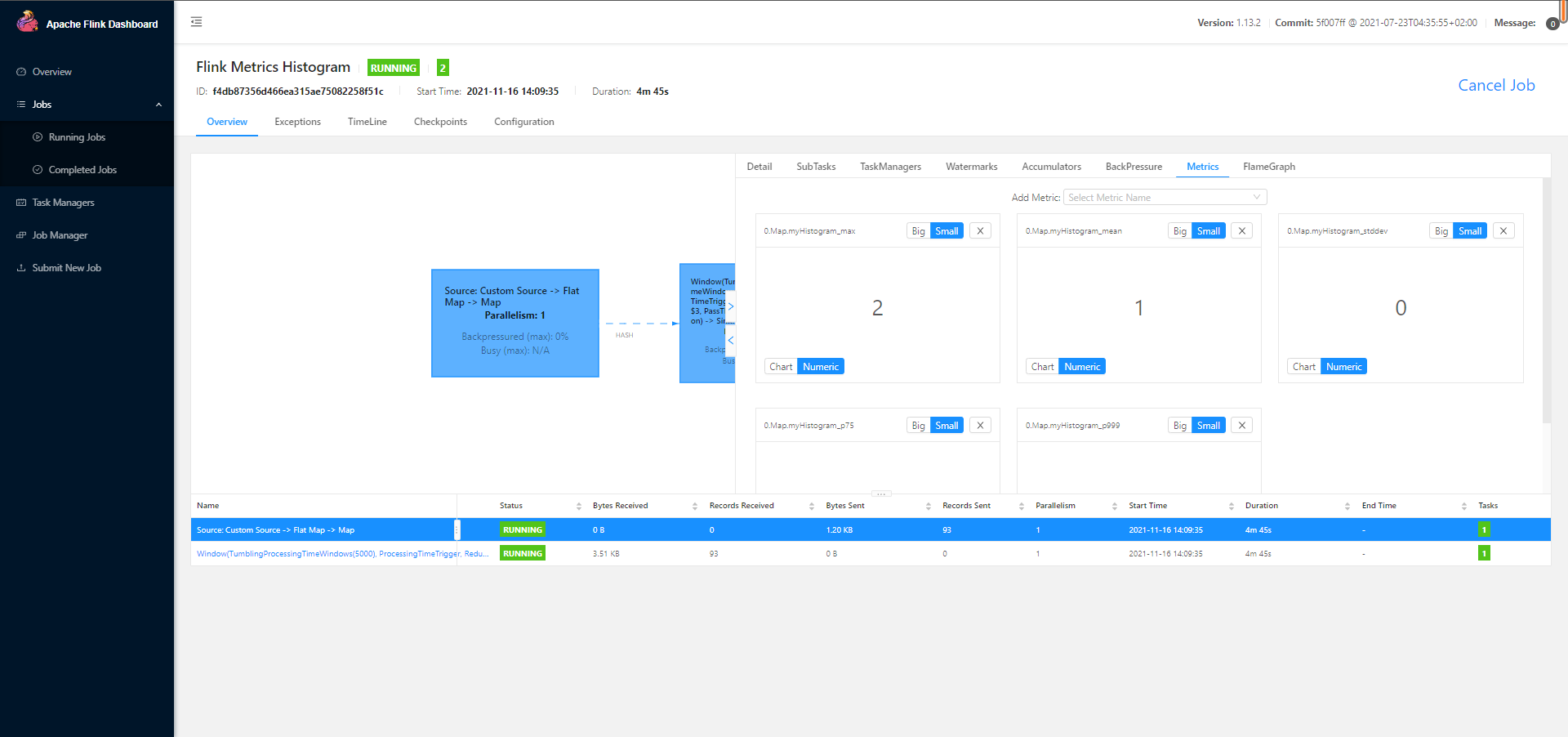
火焰图
火焰图(Flame Graph)是由 Linux 性能优化大师 Brendan Gregg 发明的,和所有其他的 profiling 方法不同的是,火焰图以一个全局的视野来看待时间分布,它从底部往顶部,列出所有可能导致性能瓶颈的调用栈。
- 每一列代表一个调用栈,每一个格子代表一个函数
- 纵轴展示了栈的深度,按照调用关系从下到上排列。最顶上格子代表采样时,正在占用 cpu 的函数。
- 横轴的意义是指:火焰图将采集的多个调用栈信息,通过按字母横向排序的方式将众多信息聚合在一起。需要注意的是它并不代表时间。
- 横轴格子的宽度代表其在采样中出现频率,所以一个格子的宽度越大,说明它是瓶颈原因的可能性就越大。
- 火焰图格子的颜色是随机的暖色调,方便区分各个调用信息。
- 其他的采样方式也可以使用火焰图, on-cpu 火焰图横轴是指 cpu 占用时间,off-cpu 火焰图横轴则代表阻塞时间。
Flink在1.13.1版本之后已经支持火焰图的开启,只需要在flink-conf.yaml 中指定即可
rest.flamegraph.enabled : trueFlink作业如下
package cn.hphblog.job;
import com.codahale.metrics.SlidingWindowReservoir;
import com.google.gson.Gson;
import org.apache.flink.api.common.functions.FlatMapFunction;
import org.apache.flink.api.common.functions.ReduceFunction;
import org.apache.flink.api.common.functions.RichMapFunction;
import org.apache.flink.api.common.restartstrategy.RestartStrategies;
import org.apache.flink.api.common.serialization.SimpleStringSchema;
import org.apache.flink.api.common.time.Time;
import org.apache.flink.api.java.tuple.Tuple2;
import org.apache.flink.configuration.Configuration;
import org.apache.flink.dropwizard.metrics.DropwizardHistogramWrapper;
import org.apache.flink.metrics.Histogram;
import org.apache.flink.streaming.api.TimeCharacteristic;
import org.apache.flink.streaming.api.datastream.DataStreamSource;
import org.apache.flink.streaming.api.datastream.KeyedStream;
import org.apache.flink.streaming.api.datastream.SingleOutputStreamOperator;
import org.apache.flink.streaming.api.environment.StreamExecutionEnvironment;
import org.apache.flink.streaming.connectors.kafka.FlinkKafkaConsumer;
import org.apache.flink.util.Collector;
import java.util.Properties;
public class MyFlameGraph {
public static void main(String[] args) throws Exception {
StreamExecutionEnvironment environment = StreamExecutionEnvironment.getExecutionEnvironment();
environment.setStreamTimeCharacteristic(TimeCharacteristic.ProcessingTime);
Properties props = new Properties();
//指定kafka的Broker地址
props.setProperty("bootstrap.servers", "hadoop102:9092,hadoop103:9092,hadoop104:9092");
//设置组ID
props.setProperty("group.id", "My_FlameGraph");
props.setProperty("auto.offset.reset", "earliest");
//kafka自动提交偏移量,
props.setProperty("enable.auto.commit", "false");
//{"Id":295,"Name":"Nmae_295","Operation":"add","t":1636887111,"opt":0}
FlinkKafkaConsumer<String> kafkaSouce = new FlinkKafkaConsumer<>("us_ac", //指定Topic
new SimpleStringSchema(), //指定Schema,生产中一般使用Avro
props); //Kafka配置
//checkpoint开启
environment.enableCheckpointing(5000);
//重试策略开启
environment.getConfig().setRestartStrategy(RestartStrategies.fixedDelayRestart(2, Time.seconds(2)));
DataStreamSource<String> streamSource = environment.addSource(kafkaSouce);
SingleOutputStreamOperator<Tuple2<String, Integer>> flatMap = streamSource.flatMap(new FlatMapFunction<String, Tuple2<String, Integer>>() {
@Override
public void flatMap(String s, Collector<Tuple2<String, Integer>> collector) throws Exception {
UserAction userAction = new Gson().fromJson(s, UserAction.class);
collector.collect(Tuple2.of(userAction.getOperation(), userAction.getOpt()));
}
});
//flink Histogram Metrics
flatMap.map(new RichMapFunction<Tuple2<String, Integer>, Tuple2<String, Integer>>() {
private transient Histogram histogram;
@Override
public void open(Configuration parameters) throws Exception {
com.codahale.metrics.Histogram dropwizardHistogram =
new com.codahale.metrics.Histogram(new SlidingWindowReservoir(500));
this.histogram = getRuntimeContext()
.getMetricGroup()
.histogram("myHistogram", new DropwizardHistogramWrapper(dropwizardHistogram));
}
@Override
public Tuple2<String, Integer> map(Tuple2<String, Integer> value) throws Exception {
this.histogram.update(value.f1);
return value;
}
});
KeyedStream<Tuple2<String, Integer>, String> tuple2StringKeyedStream = flatMap.keyBy(x -> x.f0);
tuple2StringKeyedStream.timeWindow(org.apache.flink.streaming.api.windowing.time.Time.seconds(5)).
reduce(new ReduceFunction<Tuple2<String, Integer>>() {
@Override
public Tuple2<String, Integer> reduce(Tuple2<String, Integer> t1, Tuple2<String, Integer> t2) throws
Exception {
return Tuple2.of(t1.f0, t1.f1 + t2.f1);
}
}).print();
environment.execute("Flink FlameGraph ");
}
}
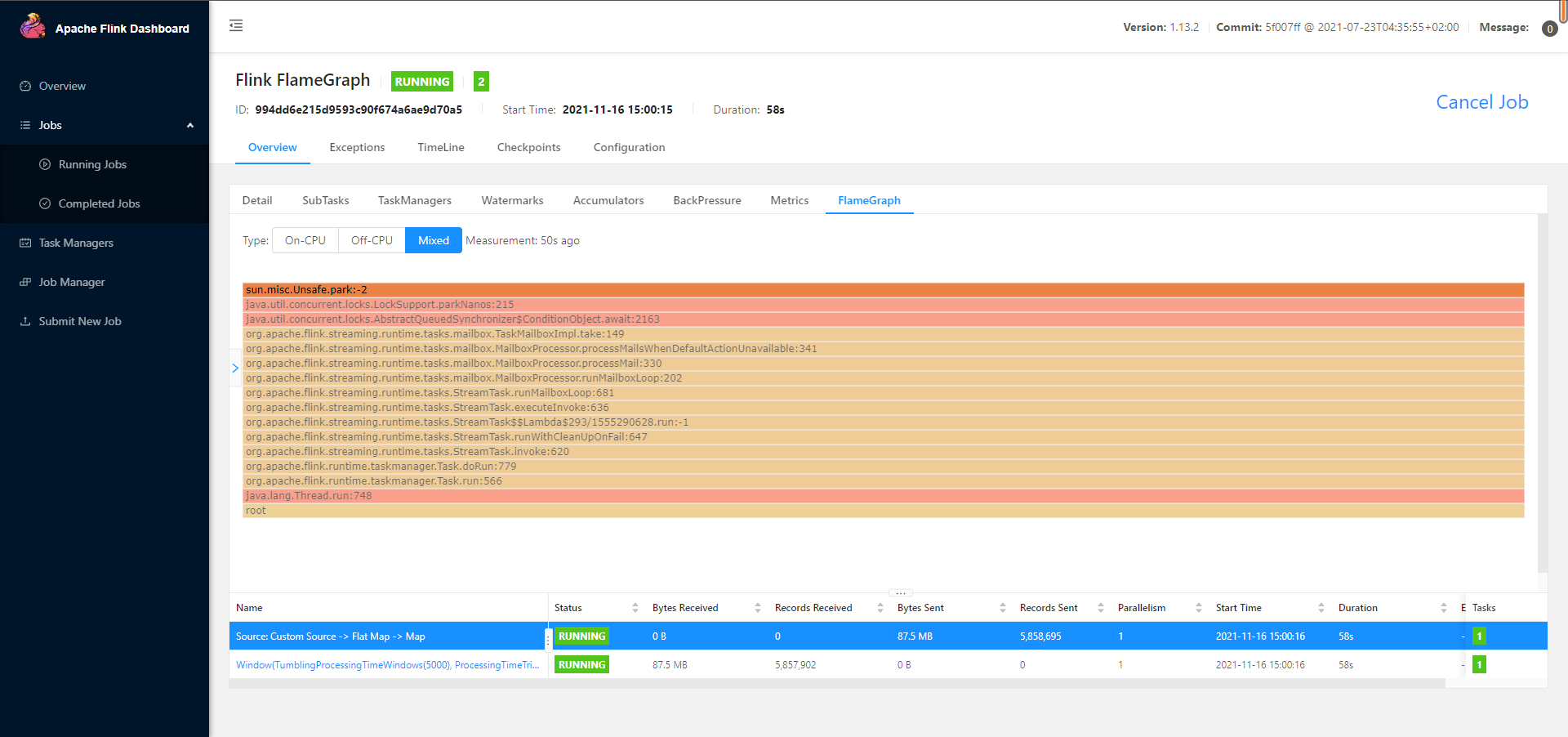
火焰图分析技巧
- 纵轴代表调用栈的深度(栈桢数),用于表示函数间调用关系:下面的函数是上面函数的父函数。
- 横轴代表调用频次,一个格子的宽度越大,越说明其可能是瓶颈原因。
- 不同类型火焰图适合优化的场景不同,比如 on-cpu 火焰图适合分析 cpu 占用高的问题函数,off-cpu 火焰图适合解决阻塞和锁抢占问题。
- 无意义的事情:横向先后顺序是为了聚合,跟函数间依赖或调用关系无关;火焰图各种颜色是为方便区分,本身不具有特殊含义
参考资料
https://www.infoq.cn/article/a8kmnxdhbwmzxzsytlga
https://nightlies.apache.org/flink/flink-docs-release-1.13/zh/docs/ops/metrics/
https://cloud.tencent.com/developer/news/473085
https://www.cyningsun.com/03-28-2020/site-reliability-engineering.html

